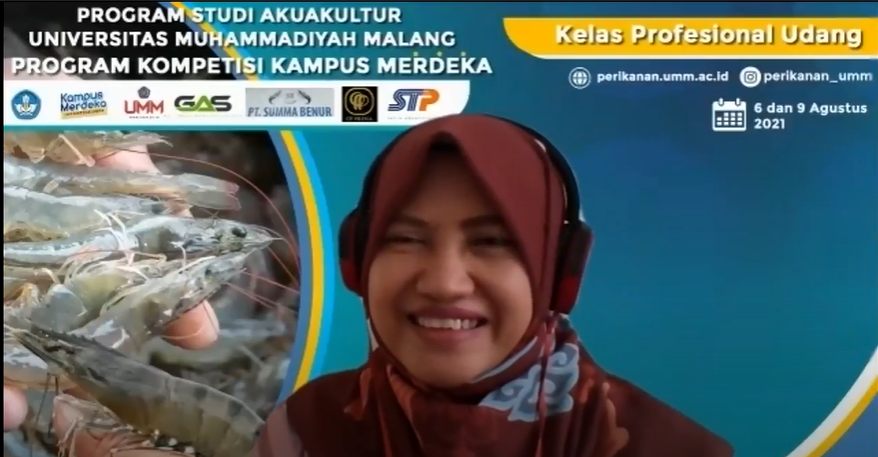 |
| Dr.Ir.Heny Budi Utari, MSi from CP.Prima who gave material on shrimp health management in the shrimp professional class |
The Shrimp Professional Class which was formed by the Aquaculture Study Program, Faculty of Agriculture-Animal Science UMM invited two experts to discuss the challenges in shrimp farming. The discussion which was held online on Monday (9/8) is for students who are interested in this field. According to the first speaker, Sarwana as Head of TS and Training Center of PT. Suri Tani Pemuka, overfeeding and disease are problems in shrimp farming. The speaker from the Aquafeed Division said that feeding which generally uses the traditional method by spreading it has the potential that some of the feed will not be eaten by the shrimp. This will trigger the disease due to the accumulation of leftover feed waste at the bottom of the pond. "It is time for farmers to switch to an intensive cultivation system to maximize profits," said Sarwana. One of the technology developments to overcome this overfeeding problem is the autofeeder machine.
The autofeeder machine is equipped with components that can be set to feed slowly at certain time intervals within a predetermined duration. With automatic settings, it makes it easier for farmers to control the amount of feed. Controlled feed is expected to reduce feed waste at the bottom of the pond, so the water quality will be maintained. However, the autofeeder technology still has weaknesses, especially if it is applied to small ponds, because the feed that comes out of the machine can be thrown outside the pond area. "In addition, during the rainy season, sometimes the feed pellets tend to be sticky due to being wet so they cannot get out of the machine," said Sarwana.
The second problem in shrimp farming is disease outbreaks. According to Dr.Ir.Heny Budi Utari, MSi who is the Head of Div. FM Technical Service & Lab from CP. Prima, 90% of deaths in aquaculture are caused by disease. "It's time for farmers to implement health management in shrimp farming," said Heny. According to him, Biosecurity is a solution to overcome this disease, one of which is feed and waste management. By minimizing the residual feed waste at the bottom of the pond, it shows the implementation of water quality management, so that shrimp health is maintained. "What if we want to apply this management to household scale cultivation?", asked Riza Rahman Hakim, aquaculture lecturer. "For home-scale cultivation, at least one must have tools to control water quality, such as a water transparency check, pH meter and thermometer," concluded Heny in the discussion session. (RAN/hum)